This might come as a surprise, but there are many different types of copywriting.
People talk about it like copywriting is just one profession, but in reality, it’s a category of jobs and skill sets.
Personally, I’ve done almost all of these – and I’ll give you some insights into which ones I like best.
Regardless of which one you choose though, there’s always lots of well-paid work for a skilled copywriter.
The biggest question is, what type of copywriting would be right for you?
Before answering that question, we need to discuss what copywriting is and what copywriters do to make sure it’s even a good fit for you.
Let’s dive in.
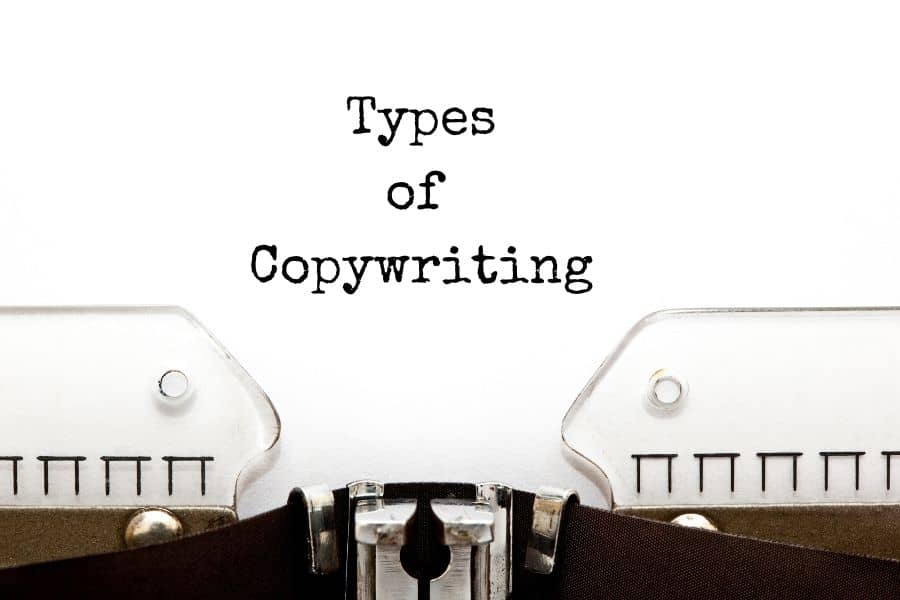
What is Copywriting?
Simply put, copywriting is the art of persuading people to take a desired action.
It’s not just making a sales pitch. You may want them to buy a product or service, download a report, complete a questionnaire, or do any number of things.
Writing copy isn’t limited to just the written word either. When you hear an ad on the radio or watch a commercial on TV, a copywriter wrote that.
The demand for quality copywriting is almost endless: billboards, brochures, catalogs, emails, flyers, jingle lyrics, scripts for inbound phone calls, etc.
In short, copywriters make the sales and marketing process come alive — they are its voice.
What Does a Copywriter Do?
It’s tempting to think copywriting simply means throwing some buzz words on a page and calling it a day.
Nothing could be further from the truth.
A successful copywriter knows the prospect better than they know themselves.
They exhaustively research what drives their customers to act and why.
They show the prospect the benefits of the product or service and how it will improve their lives.
They also communicate that information clearly and concisely to resonate with the audience.
Sometimes you are writing copy for a client. Other times, you are writing for yourself.
I’ve done both, and I’ll be honest… writing copy for your own products and services pays better!
The copy I’ve written here at Smart Blogger has brought in more than $15 million in sales and made me a millionaire.
But that’s not where I started. For years, I wrote copy for clients like Neil Patel and Copyblogger.
It paid well, but the real benefit was the experience of writing copy and then immediately getting to see results. I also got feedback and continuously improved over several years.
Without that experience, I know for certain I wouldn’t be nearly as successful as I am now.
Top 10 Types of Copywriting
Not all copywriting is the same. Different niches require slightly different skill sets.
While it’s okay to experiment to find the one you’re best suited for, it’s recommended that you focus on only mastering one or two types of copywriting. If you want to expand your range of offerings in the future, feel free.
However, many successful copywriters focus on mastering only one or two of these skills, and have created wildly successful businesses using this strategy.
You can too.
Now then, let’s explore the several different types of copywriting.
1. B2B Copywriting
B2B (business-to-business) copywriters help companies market products and services to other businesses. Although individuals may also buy the product or service, they’re not the primary focus.
Writing for businesses is much different than writing for individual consumers:
- Business sales material is often stuffy and boring. A B2B copywriter that knows how to communicate these same points in a clear and conversational tone will always be in-demand.
- Unlike retail consumers who may have different reasons for buying something, the motivations for business customers often boil down to saving or making more money.
- The B2B sales process is typically very long. And because customers explore multiple vendors before buying, every lead must be carefully nurtured. Thus, there needs to be a lot of fresh material that often makes the same points from different angles.
- The more expensive the item, the more people involved in the purchase decision. Each stakeholder will have different concerns and require unique sales material.
And so on.
The variety and amount of sales copy needed in B2B is staggering: white papers, case studies, press releases, ebooks, a blog post, sell sheets, etc
You can also get paid to write ads to bring in customers. Big B2B companies might spend millions on ads on platforms like Google and Linkedin. If you can write ad copy that gets people to click, you can make excellent money cranking out variations for your client to test.
Or my personal favorite: cold email.
B2B companies will often cold emails to decision-makers in big companies. They pay copywriters to write an email that gets executives to open and reply.
It works well. I’ve personally cold email to find partners, sponsors, and clients, and my skill as a copywriter made it WAY easier.
The bottom line: there’s a ton of opportunity for B2B copywriters.
On one project you might be writing a white paper on small business trends for Salesforce. And on another, you may find yourself crafting clever billboard copy for Shopify:
2. Brand Copywriting
Brand copywriting is unlike any of the other types of copywriting.
Typically, marketers are concerned about tangible metrics: sales volume, leads generated, email subscribers added, etc.
Brand copywriting focuses on raising brand awareness, not immediate, measurable returns. The focus is on making consumers feel more positive about a company and its products. Sales are an indirect result.
The goal is to get people to think of the company first when they want a soft drink, motorcycle, handbag, or brand of toilet paper.
Remember Don Draper from Admen? He was a brand copywriter.
Big companies pay top dollar for just the right message to make people remember them and buy their products. It’s the ultimate long-term investment, often taking years or decades to pay off in terms of brand awareness.
Perhaps the company most famous for its brand awareness copywriting is Coca-Cola:
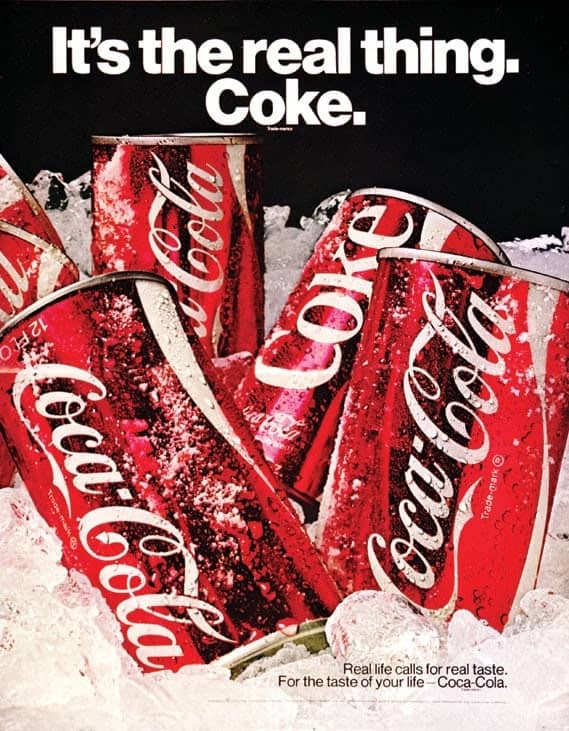
3. Social Media Copywriting
This is a new one.
With the rise of social media, lots of businesses and even individual influencers are hiring copywriters to write social posts of various types.
Why?
Because social media marketing is all about grabbing and maintaining attention. It falls squarely within the skill set of copywriters.
This includes written posts as well as scripts for shorts and even full YouTube videos. Behind the scenes, many top YouTubers like Ali Abdaal have social media copywriters to create scripts for their videos.
In my case, I’ve used my social media copywriting skills to write several viral tweets, one of which has been read by over 1 million people:
Other social media copywriters like Dakota Robertson have made millions ghost writing posts for other people:
It’s a wild niche with a lot of opportunity. If you love social media, this one could be for you.
4. Direct Response Copywriting
When people think of copywriting, they usually think of direct response copywriting (sometimes called “sales copywriting”).
The term is a holdover from the days when sales material came to you via print magazines, print newspapers, and “junk mail.”
But it also applies to ad copy, sales letters, opt in pages, and anything else that motivates prospects to take action immediately. It’s still very much alive.
Where brand copywriting focuses on building awareness over the long-term, direct response copywriting focuses on getting the sale as quickly as possible. They are on two different ends of the copywriting continuum.
Typically, small businesses invest in direct response copywriting, because they can’t afford to wait for years for their ads to pay off. They need results now, and the direct response copywriter
The goal could be to persuade a prospect to share their email address, schedule an appointment, attend a webinar, or upgrade their order. Anything that moves people closer to buying.
Personally, I consider myself a direct response copywriter. Take this landing page for example:

There are only two choices on the page. You can either give your email address for the freebie or leave.
It’s highly effective too. Over 60% of visitors to that page subscribe.
That’s direct response copywriting.
5. Email Copywriting
Email copywriting is a specialized kind of direct response copywriting. It provides 1:1 interaction with the reader like no other digital marketing method can.
Unlike many other marketing messages shown to people uninterested in what you have to offer (e.g. display ads), the subscribers on your email list are at least somewhat interested in what you have to say.
However, it’s still hard work to sway subscribers to open the email, and even harder work to retain their trust. Once consumers feel you no longer offer them any value, they’ll unsubscribe in a heartbeat.
The great thing about this marketing channel is its tremendous ROI. That means skilled email copywriters will always be in demand.
Let’s look at email marketing in action.
Below is a questionnaire example from MomandDadMoney. Is there a better way to better understand your audience than asking them directly 1:1?
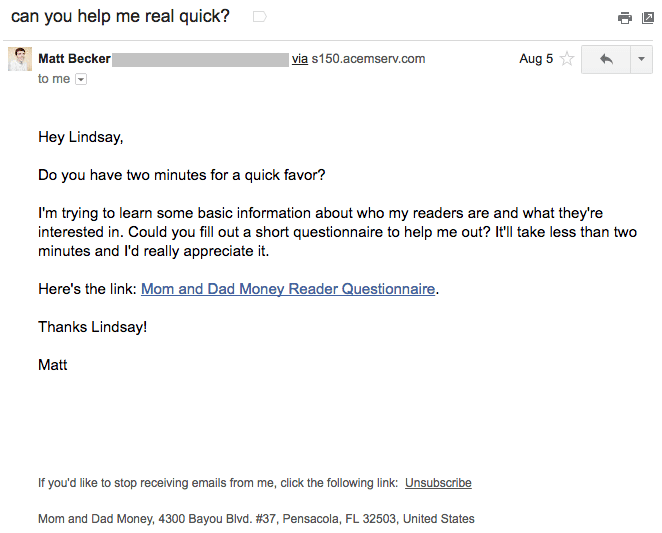
6. Public Relations Copywriting
Public relations copywriting (PR copywriting) is another specialized type of copywriting.
A successful press release must have a well-crafted hook that compels the reader to take action and states your value proposition in less than 500 words.
All too often, companies neglect the importance of a well-written press release. And instead of hiring a copywriter to write a clear, high-quality PR piece, they patch something together with a fill-in-the-blank template and hope for the best.
The end result is a poorly written effort that comes across as spam and is promptly ignored.
A copywriter that knows how to write good press releases (and get them into the hands of the right people) will always be in demand.
If a client has anything noteworthy: a new product, special event, leadership change, or breaking news, it is a candidate for a press release.
Here’s an example of the type of press releases a PR copywriter might create:
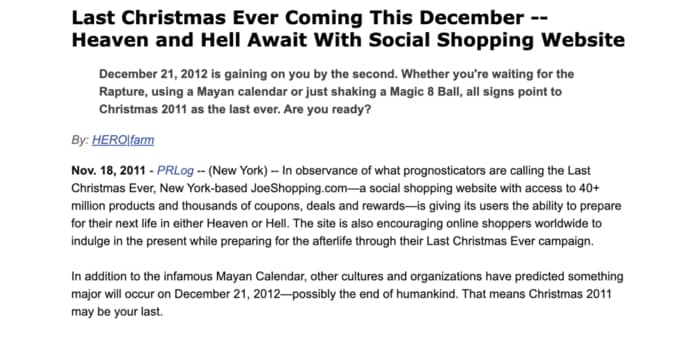
Does that look like a template to you?
7. SEO Copywriting
SEO copywriting is a subset of content marketing. Unlike other types of copywriting, its main purpose is to get articles ranked as high as possible in a search engine.
This article is an example. I’m praying to the Google gods that it ranks. 🙂
So I guess you could call me an SEO copywriter. While writing this, I’m thinking about making the article valuable for you, but I’m also thinking about all kinds of other technical things like searcher’s intent, time on page, and keywords.
The bad news?
Unlike most copywriting options discussed here that can be used on a per-project basis, SEO Copywriting principles must be applied to the entire site to be effective. So if a client hires you to write one article, your SEO copywriting efforts may not pay off if the rest of their site isn’t optimized.
AI is also disrupting the SEO space, and it’s possible it won’t exist in a few years. No one really knows. For that reason, many companies are hiring far fewer SEO copywriters than they used to.
8. AI Copywriting
AI copywriting refers to using apps like ChatGPT to speed up the writing process.
You can ask the AI to write emails, sales letters, pretty much anything on this list. It understands the basics of copywriting and all of the frameworks to write decent copy.
But it’s not perfect. AI struggles to empathize with humans. It also lacks a sense of “taste” – it struggles to tell the difference between good copy and bad copy.
For that reason, it’s not a replacement for a copywriter. It’s like putting a copywriter on steroids.
I use AI to write all of our sales letters and email copy these days. It makes me 10X faster.
But I have to tell it exactly what I want.
For example, you can ask ChatGPT to write you a sales letter, and it will give you a bunch of mediocre copy. However, if you ask it to write the introduction to a sales letter using PAS copy, you’ll get far better results.
What’s PAS copy? It stands for problem, agitate, solve. It’s a copywriting technique.
The only reason I know to ask for that is because I’m a copywriter. A business owner wouldn’t even know the term.
So I don’t think copywriter’s are going away anytime soon. However, the best copywriters will be able to do 10X more work with AI and get results 10X faster.
9. Technical Copywriting
Technical copywriting is probably one of the most challenging types of copywriting. It’s copywriting for the science and technology fields.
Technical writers break complex concepts into terms the layperson can understand. They create how-to manuals, reference guides, and so on.
A technical copywriter uses those simplified terms to sell goods and services. They are educators, as well as salespeople.
And as you might guess, finding people qualified to do both is not easy.
Most copywriters are fine with everyday products like pet food, travel, and laundry detergent.
However, unless someone has a STEM background, they may struggle to write successful copy for products that require specialized education and many years of experience to understand.
Because of the lack of people qualified to do the copywriting job, those who can write technical copy often write all the marketing material:
- Case Studies
- White Papers
- Brochures
- Emails
And more.
For example, check out technical copywriter William C. Blake’s portfolio page. Note the range of services he offers:
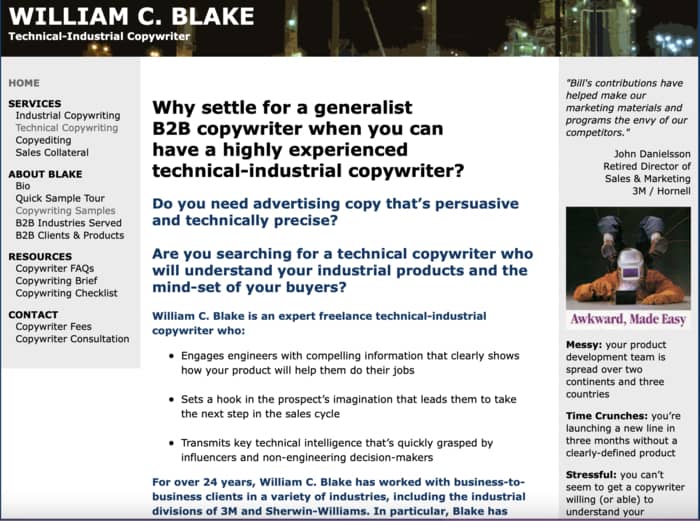
10. UX Copywriting
UX, or User experience, copywriting is a form of website copywriting that involves the entire user experience from start to finish.
Whether someone performs the action you want depends upon their feelings and confidence (read: trust level) about everything on the page.
- How easy was it for them to find what they needed?
- How fast did the page load?
- Were the instructions clear?
- How did the graphics make them feel?
And so on.
Basically, how comfortable were they interacting with your website copy? Every interaction generates feelings, either good or bad.
If more of those interactions are positive than negative, the user’s experience will be good. The opposite will also be true.
In the hypercompetitive world of online marketing, you want the user experience to be as positive as possible.
The little things matter.
UX Copywriting is far more holistic than the other forms of marketing copywriting we discussed. It goes way beyond the words on the page.
Because there are so many elements to effective UX copywriting, a single graphic is unlikely to offer you much value.
Further Reading: UX Copywriting: What You Need To Know (Examples Included!)
What Types of Copywriting Will You Try?
The list above is not exhaustive by any means, and the lines between them are not always well-defined either.
However, you now have a much better idea of what copywriters do and the types of copywriting jobs out there.
Regardless of which part of the copywriting world you choose, the core functions are always the same – getting people to take action.
As long as there are goods and services to sell, the world will need compelling copy to sell them.
Good luck finding your first copywriting client!






